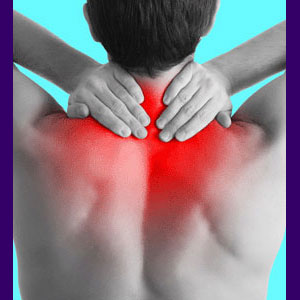
A neck spasm is an agonizing death-grip applied to the muscles of the neck, and possibly the surrounding soft tissue in parts of the face or upper back. Muscle spasms in the neck can affect the head, face, jaw, shoulders and arms directly, or sympathetically, and may cause considerable discomfort for an extended period of time. Many patients may be completely unable to do anything at all, except suffer under the crushing pressure, until the spasm releases.
This treatise explores the unrivaled misery caused by chronic or acute neck muscle spasms.
Neck Spasm Symptoms
Spasms are characterized by uncontrollable repeated or constant tightening of the involved muscular tissues. The feeling is very painful and is also commonly referred to as a cramp or charlie horse. Cramps in the neck will also affect the musculature in the surrounding anatomical regions. Depending on the cervical spinal level affected, these symptoms might be centered in the face and head or in the shoulders, arms and upper back.
Muscle spasms can be very frightening and can also create neurological effects in their wake. Tingling, weakness, numbness or residual pain are all components of the lingering aftermath of a powerful spasm. Patients are also likely to suffer fear of a recurrence which may bring on muscular tension or even acute anxiety.
Neck Muscle Spasm Causes
Muscle spasms can result from a problem in the spinal anatomy, but are far more likely to occur from direct soft tissue injuries or a regional process, such as ischemia. Severe back muscle sprains and strains can cause spasms to occur for several minutes to several days, depending on the nature and severity of the injury.
Oxygen deprivation back pain is one of the most prevalent sources of regular idiopathic spasms and often goes undiagnosed for a very long time. Remember, the typical reason for a muscle to go into spasm involves depletion of available oxygen. This is exactly the process enacted by psychosomatic back pain conditions, even though the blame for these symptoms is most often placed on some coincidental spinal abnormality or soft tissue condition, such as thoracic outlet syndrome.
Neck Pain Spasms
Coping with spasms anywhere in the anatomy can be a trying and nightmarish experience. While some spasms are small and insignificant, others are truly agonizing. Luckily, the degree of the pain most often does not have any correlation to the underlying severity of the condition. In fact, severe spasms can occur for completely idiopathic reasons and are typically also linked to emotional stress and the subconscious repression process. Of course these can also be positional or activity-related concerns, as well.
They may be no ideal treatment for a spasm already in full effect. Most patients are advised to simply relax (as if this is even possible) and wait for it to pass. Patients who are suffering recurrent neck spasms and have also tried a variety of back pain treatment options, may still have hope, particularly if no structural source is diagnosed.
A popular alternative treatment called knowledge therapy has been recommended by such notable back pain pioneers as Dr. John Sarno of the NYU Medical Center, Rusk Institute of Rehabilitation Medicine. I find that although not useful for all types of pain, the benefits to be gained can improve the quality of virtually any patient’s life and may even help them to reduce their symptoms, including decreasing the incidence of painful spasms.
Of course there is also the pharmaceutical route, with such common drugs as Flexeril, Skelaxin and Soma being prescribed in huge numbers to patients worldwide. Just be careful with these, as there are obvious and lesser known risks to these products, particularly when used long-term.




